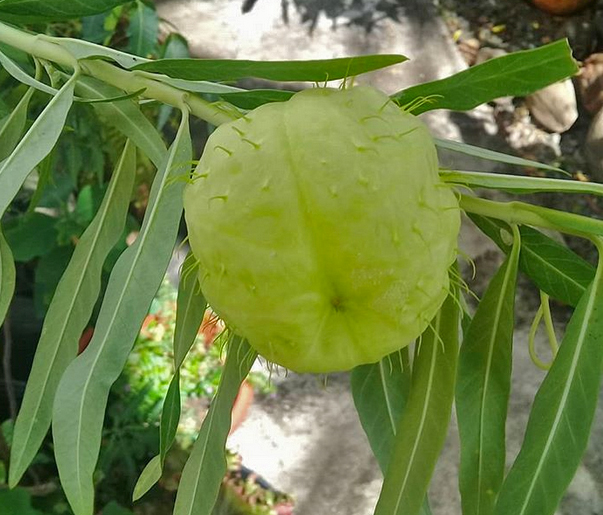This poor plant! How can it overcome its questionable appearance?
https://www.instagram.com/p/BtMqjBYlqMR/
The first image… it’s obviously a milkweed! The second picture… wait… what?

That is just weird.
This plant is growing in my landlady’s garden. She called me on the phone and said, “David! You have to see this thing!” In Spanish, it is called “collons del abuelo.” Okaaaaaaaaaaay, then.
So I went down and looked at it. Yep, that is weird. No, I don’t want to talk about it.
The plant is named Gomophocarpus physocarpus.
According to the University of Wisconsin-Madison Master Garden Program:
“Gomphocarpus (=Asclepias) physocarpus is a plant in the milkweed family (in the subfamily Asclepiadoideae of the Apocynaceae, formerly the Asclepiadaceae) often used as an ornamental for the striking yellowish, ball-like fruits. The name physocarpa comes from the Greek physa meaning bladder and karpos, fruit, referring to the inflated, bladder-like fruits. It has a plethora of common names including balloon plant, balloon cotton-bush, balloon milkweed, bishop’s balls, elephant balls, hairy balls, monkey balls, swan plant, and many others. This quick-growing, short-lived species native to tropical Africa is used as a seasonal annual in the Midwest, although it is actually a tender perennial (zones 8-10). It has naturalized in many places in the world, and is a weed in many areas with a mild climate. There is a very similar plant, G. fruticosus, which is less common in the ornamental trade. It is smaller in stature, not as vigorous, and the seed pod is slightly oblong (supposedly resembling a swan). But the common names of “swan” and “balloon” plant are used interchangeably for both species.
The leaves are narrow and lanceolate.
Balloon plant is an upright, herbaceous plant or soft shrub that can grow over 6 feet tall from the fibrous roots. The slender, single-stemmed trunk has multiple hollow, pale yellowish green branches. The smooth textured, light green, opposite leaves are 3-4 inches long. They are narrowly oblong to lanceolate. All parts of this plant exude milky white latex that is mildly poisonous if ingested.”
Like other milkweeds, it’s a host for Monarch butterflies. It’s also a great conversation piece.
Yep, I’m going to plant one of my own… just gotta wait for those seeds to ripen up.


1 comment
Oh wow, that is a beautiful plant and it will grow here to boot. Now to find one or the seeds.
Comments are closed.